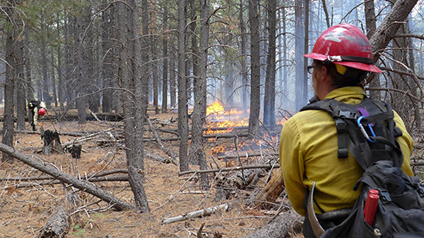Last updated: August 2, 2022
Article
Part I – Before a Wildland Fire: Concessioner Preparation

As an increase in fire weather approaches, this three-part series will provide concessioners with information on how to manage operations before, during, and after a wildfire. The planning strategies and resources outlined in this series may also be used for other types of natural disasters.
Wildfire Season is Shifting to a Year-Round Approach
The growing severity of wildfires has sparked discussions on year-round fire danger. National Park Service (NPS) sites in affected areas must learn to live with wildfire as the risk increases due to an increase in fire weather.
Wildfires can be caused by lightning, lava, and other natural causes but 90 percent of wildfires are caused by humans. 52,641 wildfires were caused by people in 2021. It is everyone’s responsibility to understand wildfire risks and take precautions to mitigate wildfire ignition.
All NPS units are required to have a fire management plan with appropriate environmental compliance as outlined in Reference Manual 18. Always follow wildfire prevention guidance from fire management staff and park leadership. Daily fire danger levels can be found on the U.S. Forest Service website.
Before a Wildfire, Take Precautions and Plan Ahead
A wildfire burning near buildings can cause structural fires to ignite. Creating defensible space acts as a buffer between a structure and the wildland. The less fuel (dry grass, shrubs, firewood, etc.) between a burning forest and a structure, the more likely the structure will remain safe.
Coordinate with your park and fire management staff to create defensible space around structures. Maintaining lawns, clearing brush, trees, and other flammable materials away from structures helps keep buildings, residents, and firefighters safe. As weather becomes warmer and vegetation, trees, and forest floors begin to dry out, take precautions with maintenance equipment and vehicles that could put sparks out into dry areas.
Communication
Wildfires happen fast: be prepared for an evacuation, and remember that human safety comes first. Ask park staff if a communication plan is in place. Communicate with park and concession staff ahead of time to outline a simple framework to follow in case of network disruptions, or loss of access to mobile devices.A communication plan does not provide guidance on evacuation or emergency response.
A communication plan simply allows for open communication, notification, and updates between concession staff during an emergency. Always follow guidance from park and emergency response personnel. Communicate and coordinate your plan with the appropriate park personnel, starting with your concession specialist.
For example, a simple but effective PACE (primary, alternate, contingency, emergency) communication, evacuation, and safety plan can help park concessioners communicate during an emergency.
-
Primary: The main form of communication. This form of communication should be expected. Think about what form of communication is typically used to communicate with other staff.
-
Alternate: If your primary form of communication fails, what is the best way to reach others? How will you find that information? Keep in mind that Wi-Fi and cellular service might not be available.
-
Contingency: Tertiary method of communication. A satellite phone, radio, or other form of communication that do not rely on a signal may be necessary.
-
Emergency: If no other plan works, have important contact information written down and accessible. When preparing for an evacuation, make sure vital contact information is available when you can reach other people.
The most important part of any communication plan is having a plan and making others aware of it. Concessioners should ensure their communication plan is understood by their staff and coordinated with park personnel. Carrying an external battery or charger for your devices allows for emergency access to communications during a disaster. Staff may be dispersed due to the fire, keeping an up-to-date contact list handy can allow concessioners to communicate quickly with others.
Documentation
Prepare by keeping important documents backed up electronically. While evacuating, grabbing your insurance documents and contract information may be the last thing on your mind. Keep this information backed up virtually before you need it. Talk to your concession specialist or park point of contact to find out what materials you need in the event of a wildfire. Review your insurance coverage before an increase in fire weather days to make sure you have enough coverage in the event of a fire. Understanding the requirements for insurance minimums should be coordinated through your park concession specialist. They can help ensure you have the appropriate coverage.
Resources
Visit Ready.gov for more information on creating a PACE plan and view free templates and materials. Planning can be the most effective way to remain safe, calm, and ready to respond quickly during a wildfire. Understand the NPS Director’s Order #18, pertaining to wildland fire management.
